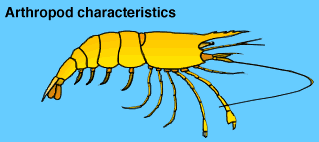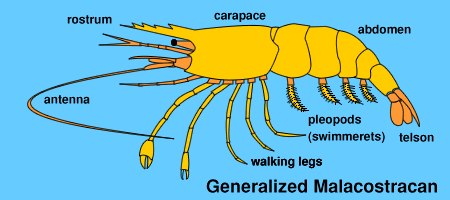|
|
Arthropods
The Phylum Arthropoda contains the Insects, Spiders, Scorpions, Harvestmen, Ticks and Mites, and the Crustaceans, which include the Barnacles, Isopods and Decapod Crabs.
In this LOARS Web Resource we are only concerned with the Arthropods which are found between the tides on rocky ocean shores.
One of the major classes within the Crustacean group is the Malacostracans. This group contains the lobsters, crabs and prawns. See the diagram above for the Malacostracan body parts.
Arthropods are a massive group of animals and have many more varieties, or species, than all the other groups combined. It is believed that 75% of all animals are Arthropods.
The name arthropod is made up from "arthro" meaning joint, and "pod" meaning leg. Arthropod legs are highly adapted for walking, swimming, feeding and gathering sensory information.
Some arthropods, such as decapod crabs can regrow severed limbs in a process called "regeneration".
Arthropods have a number of characteristics which are common.

-
A hardened external skeleton (exoskeleton) made of a protein called chiton, which covers and protects the body.
-
This hardened shell gives rigid support for the attachment of an arthropod's internal muscles.
-
The exoskeleton consists of several separated plates connected by thin membranes, which form joints. These flexible membranes allow the arthropod to flex its otherwise hardened body, legs, mouthparts and antennae to allow movement.
-
Periodically, every arthropod becomes too large for its outer shell and must shed its exoskeleton, in a process called moulting. Moulting is a particularly trying time for arthropods and they can become very vulnerable to predators at this time
-
Most arthropods have eyes.
-
Most arthropods have two separate sexes. However, some arthropods, such as the barnacles, are hermaphroditic. This means that one individual is both sexes at the same time.
| For more information on Crustaceans visit MESA Crustaceans |
References
Bennett, I. (1987) W.J. Dakin's classic study: Australian Seashores. Angus & Robertson, Sydney.
Davey, K. (1998) A Photographic Guide to Seashore Life of Australia. New Holland, Sydney.
Edgar, G. J. (1997) Australian Marine Life: the plants and animals of temperate waters. Reed Books, Kew.
Jones, D. & Morgan, G. (1994) A Field Guide to Crustaceans of Australian Waters. Reed, Chatswood.
Quinn, G. P., Wescott, G. C. & Synnot, R. N. (1992) Life on the Rocky Shores of South-Eastern Australia: an illustrated field guide. Victorian National Parks Association, Melbourne.
Marine Research Group of Victoria (1984) Coastal Invertebrates of Victoria: an atlas of selected species. Museum of Victoria, Melbourne.
Macpherson, J. H. & Gabriel, C. J. (1962) Marine Molluscs of Victoria. Melbourne University Press & The National Museum of Victoria.
Shepherd, S. A. & Thomas, I. M. (1982) Marine Invertebrates of Victoria, Pt. 1. South Australian Government Printer, Adelaide.
Underwood, A. J. & Chapman, M. G. (1993) Seashores: a beachcomber's guide. New South Wales University Press, Sydney.
Wilson, B. R. & Gillett, K. (1979) A field guide to Australian Shells: Prosobranch Gastropods. A.H. & A.W. Reed, Sydney.
Womersley, H. B. S. (1987) The Marine Benthic Flora of Southern Australia. pt.1 , South Australian Government Printer, Adelaide.
Home
Page
Taxonomy
Biogeography
Rocky Shores
Tidal Levels
Intertidal Zonation
Environmental Factors
Biological
Factors
Feeding Relationships
Activities
Glossary
References
 Life
on Australian Seashores
Life
on Australian Seashores
by Keith Davey (C) 2000
Learning Consultant
- Media
The University of Newcastle
email at australian_seashores@hotmail.com
Scientific Consultant: Phil
Colman
site created 01.01.98 : updated 01.04.2000

